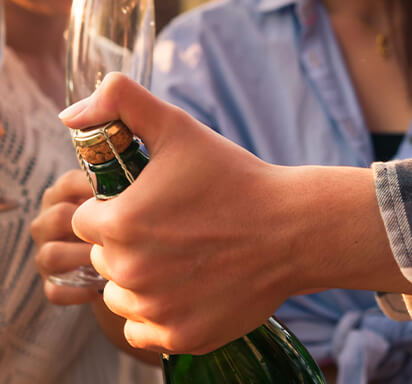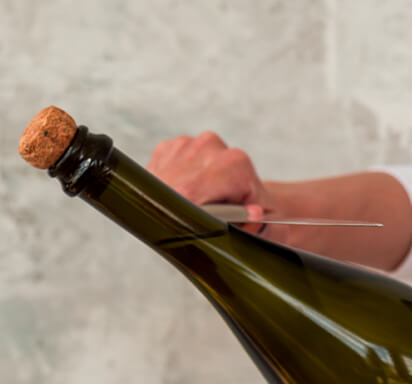All about Champagne: Learn all about What is Champagne!

We’re sure you’ve seen a bottle of it at your local wine shop or enjoyed a glass at a wedding or birthday celebration. It is, after all, one of the most sought-after sparkling wines in the world. But what is Champagne, exactly?
We’re sure you’ve seen a bottle of it at your local wine shop or enjoyed a glass at a wedding or birthday celebration. It is, after all, one of the most sought-after sparkling wines in the world. But what is Champagne, exactly? In this article we take a look at this beloved sparkling wine, which comes exclusively from the Champagne region of France.
Asking yourself “But what is the difference between champagne and sparkling wines produced outside of the Champagne region?” Take a look at our article entitled “Sparkling Wine vs Champagne” to learn more about the difference between Champagne and sparkling wine like Prosecco from Italy!
WHERE DOES CHAMPAGNE COME FROM?
First and foremost, Champagne is a sparkling wine produced in the Appellation d’Origine Controlee area of Champagne in northern France. Technically, a sparkling wine is called Champagne if and only if it is produced in the Champagne region of France. While some producers in the Unites States used to label their sparkling wines with the word Champagne, this changed in a 2006 trade agreement between the European Union and the U.S., in which the use of the word “Champagne” on the labels of American-made wines was prohibited.
French sparkling wines produced outside of the Champagne region but with the same traditional method of winemaking are called Cremant wines.
WHAT ARE THE GRAPES IN THIS SPARKLING WINE?
Champagne is a French sparkling wine made from a combination of three varieties of grapes: Pinot Noir, Pinot Meunier and Chardonnay. Several types of champagne can be made by using different grapes. For example, a Blanc de Blancs Champagne wine is made from exclusively Chardonnay, while a Blanc de Noirs Champagne is a sparkling white wine made from red grapes (Pinot Meunier and Pinot Noir) vinified as a white wine.
A rose champagne is made either by macerating the juice in the red grape skins or blending right and white base wines. Rosé champagne thus tends to blend a combination of white and red grapes (Chardonnay, Pinot Noir and Pinot Meunier).
HOW IS THIS WINE PRODUCED?
A Champagne wine is also defined by the sparkling wine production techniques used to make it. This is referred to as the traditional method or méthode champenois (Champagne method). By this traditional method, a second fermentation takes place inside the Champagne bottle in which the wine is eventually sold. A liqueur de tirage is added to the base wine before it is temporarily capped. The wine undergoes a secondary fermentation, which creates bubbles inside of the bottle. Once the yeasts have finished converting the sugar in the liquid into alcohol and carbon dioxide (bubbles), they die and become lees. As Champagne is aged for an extended period of time on the lees, this dead yeast remains in contact with the wine, imbuing it with autolytic aromas (or aromas from lees-aging), which add layers of complexity. Autolytic aromas include the brioche, marzipan and butter aromas often associated with champagne. The lees also add a rich texture to Champagne.dom perignon champagne
Before the bottle it corked, the lees are removed by a process called riddling, which involves gradually rotating the Champagne bottles to allow the sediment to drop to the neck of the bottles. Then, the bottles are inverted, and the neck frozen so that when the temporary cap is removed, the pressure in the bottle forces the sediment out. Before the bottles are corked, a final “liqueur d’expedition”, containing a dosage (sugar mixture) is added.
While the traditional method originated in Champagne, it is now also widely used to produce sparkling wines like Champagne around the world. Other traditional method sparkling wines include the Crémant wines of France, Cava from Spain, Franciacorta from Italy and Methode Cap Classique from South Africa.
WHAT ARE THE DIFFERENT STYLES OF THIS SPARKLING WINE?
Champagne is also a wine that comes in a wide range of styles and flavor profiles, which depend on the grapes and winemaking techniques used to produce them. For example, they can either be a white blend, a rosé champagne, a Blanc de Blancs champagne or a Blanc de Noirs champagne depending on whether they are made from white or red grapes and vinified as a white or red wine.
The winemaker can also set the sweetness level of a champagne by determining the dosage (sugar per liter of wine) before corking. This choice leads to champagnes that range from the dryer style, brut champagne (the most popular style, exemplified by the Veuve Clicquot Brut Carte Jaune) to brut nature (the driest category) to doux (the sweetest category).
And finally, a winemaker can choice to produce a vintage champagne (made from grapes that were all harvested in the same vintage) or a non-vintage champagne (with reserve wines from several different vintages included in the blend). Vintage champagnes tend to be aged longer than their non-vintage counterparts, lending them greater complexity and persistence on the palate. Some of the best champagnes in the world are therefore vintage champagnes.
Are you asking yourself “But where will I be able to find these champagnes near me?” Browse our online selection or visit our boutique in New York City! Have any questions about the diverse types of champagne? Our talented team of wine experts is always available to guide you through our selection and help you choose the right champagne type to suit your preferences!
You may like
Unveil the unique characteristics of Champagne Blanc de Blancs and Blanc de Noirs. Learn how these two styles differ in flavor, grape varieties, and food pairings to elevate your Champagne experience.
12/19/2024Discover how Chardonnay, Pinot Noir, and Pinot Meunier shape the distinct character of Champagne. Learn about rare grape varieties and explore notable examples from top producers in the world’s most famous sparkling wine region.
7/4/2024To help you safely open a bottle of bubbly, we have put together a guide with 6 simple steps. Learn more about when to open a bottle of Champagne and how to do it in the safest and most graceful way.
3/11/2023A swift swoop of the knife along the neck of the bottle, followed by a “pop!” as the glass shatters and the “hiss” of the Champagne as it flows out. There is no more festive way of opening a bottle of Champagne than by sabering it
3/8/2023Guardian of the bottle and the precious bubbly inside, the cork serves an essential role in the preservation of Champagne. Over the years, it has evolved and adapted to this very special role.
3/6/2023What is the best way to store Champagne or sparkling wine for the short or long term? Find here best storage practices, which will help keep your bottle of bubbly Champagne or sparkling wines fresh for as long as possible.
2/20/2023










